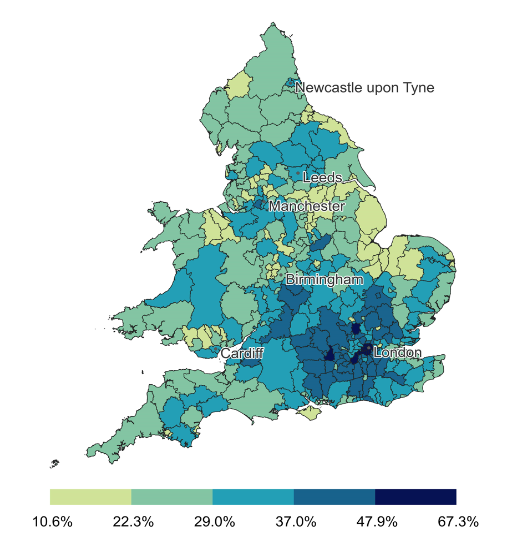The New Normal of Working From Home And Implications for Spatial Inequalities

David McCollum
The pandemic-induced shift to remote and hybrid working, in theory, presents an opportunity to address the UKs longstanding regional inequalities.
After all, why would people who can work from home elect to reside in big cities when they can live in more affordable, spacious and aesthetically appealing locales elsewhere?
The recently released data from the 2021 Census presents an excellent opportunity to understand the geography of working from home (WFH) and thus consider its implications for spatial inequalities.
In total 8.7 million (31.2%) usual residents aged 16 years and over in employment in England and Wales worked mainly at or from home in the week before Census Day, 21st March 2021. A caveat is that this relates to the covid rather than post-covid period. However, based on this data and further analysis undertaken at the University of St Andrews, it appears that the changes in working practices brought about by the pandemic have mainly reflected and reinforced existing social and spatial inequalities.
The map below based on the census data illustrates the distinctive geography of WFH. Whilst over two-fifths of workers in London (42.1%) did this, the equivalent figure in the North East was only one-quarter (24.8%). The top local authorities for WFH were concentrated in and around London (usually more than half of the workforce) whereas it was least prevalent in eastern coastal areas between the Humber estuary and the Wash (less than a fifth of workers). WFH was most prevalent in the City of London (67.3%) and least common in Boston, Lincolnshire (10.6%). Only two areas north of the classic north-south divide sit within the top 50 areas for WFH (Rushcliffe and Trafford). Statistical analysis at the local authority level shows that WFH propensity is closely correlated with share of workforce in professional and managerial jobs, qualification level, property values, pay rates and deprivation levels.

Source: Map created by Charlotte van der Lijn using data from ONS census maps, method of travel to workplace.
So why does WFH map so closely to existing spatial inequalities and what might the policy implications be? Amongst the hyperbole surrounding the new normal, it is easy to forget that most people did not and do not WFH and that this has a clear geography. Even at the peak of the pandemic in early 2021, 51% of the workforce never actually WFH. Statistically, a person was more than twice as likely to never WFH if they did not have a degree, did not work in a managerial or professional role, lived in the top fifth of most deprived areas and if they voted for Brexit.
Occupation type is a key determinant of ability to work remotely, and this is reflected in the geography of WFH: the professional white collar jobs over represented in London and the South East are more amenable to remote working than those elsewhere. Another important point is that hybrid work is more commonplace than fully remote working, meaning that even most workers who WFH have to still live within a reasonable distance of their main place of employment. These social and spatial inequalities in the prevalence of WFH have a number of policy implications.
- WFH has created a donut effect: those at well established stages of their careers are able to relocate further away from their place of work, resulting in less frequent but longer commutes. Transport infrastructure needs to be capable of supporting these new commuting patterns.
- Adequate digital infrastructure is a necessary precondition to WFH. Whilst broadband speeds in most parts of the country are sufficient for routine online interactions, investment is needed to support a more geographically dispersed distribution of the high tech, high value sectors of the future.
- Regrettably WFH has been coopted into the pervasive culture wars and societal schism narratives. However, by and large, it is a win-win-win for those who do it, their employers and their local communities. Where appropriate, WFH should thus be promoted and supported rather than stigmatised. This is especially important given that WFH can be particularly beneficial for some conventionally marginalised groups within the labour market (e.g. carers and those with disabilities and health issues).
- Place matters. People want to work and live in particular places for reasons that go beyond the jobs that they contain. The cultural offer that places can make will be key to attracting and retaining the skilled and qualified workers that have most choice regarding residential location.
- The enforced switch to remote working for almost half of the population during the pandemic demonstrated that flexible forms of working can be surprisingly effective. This success should serve as a basis for greater ambition when it comes to promoting and permitting other forms of flexible working (e.g. flexible start and finish times, compressed hours, job-shares).
- Finally, most people in most places do not WFH and ability to work remotely is clearly socially stratified. It is thus vital that the new normal does not bypass large swaths of the population and parts of the country. The pandemic briefly elevated the occupational prestige of Britain’s ‘keyworkers’, yet these largely low paid workers are currently at the sharp end of the cost-of-living crisis. Enhanced pay and conditions for those in the types of roles which cannot be undertaken remotely will be an important component of levelling up the country.
